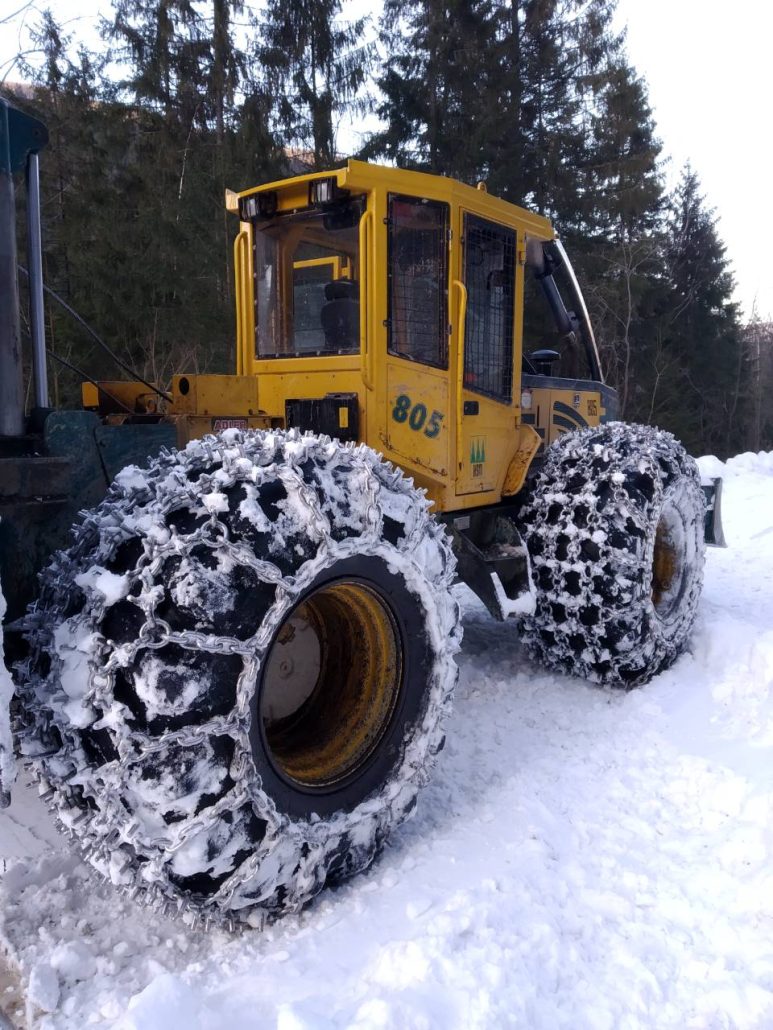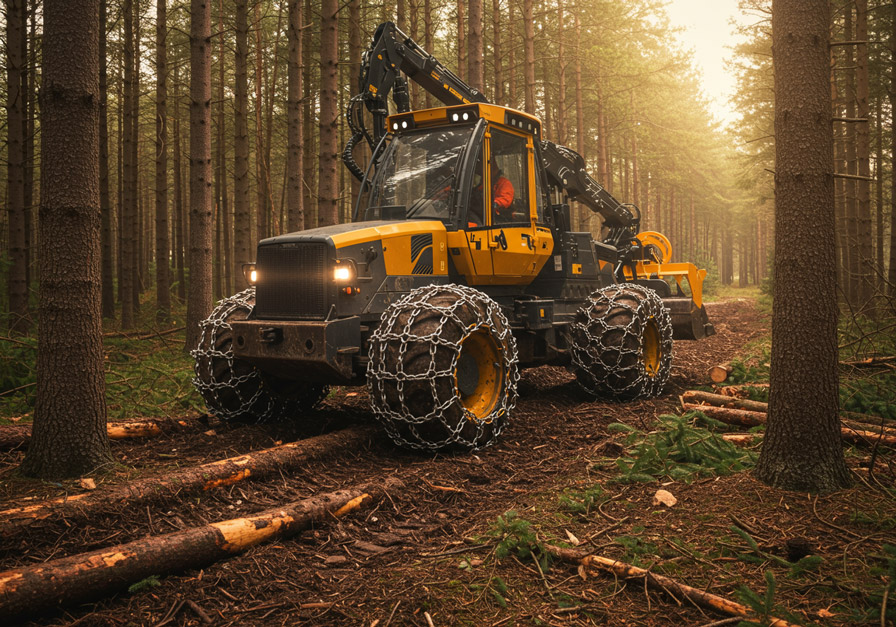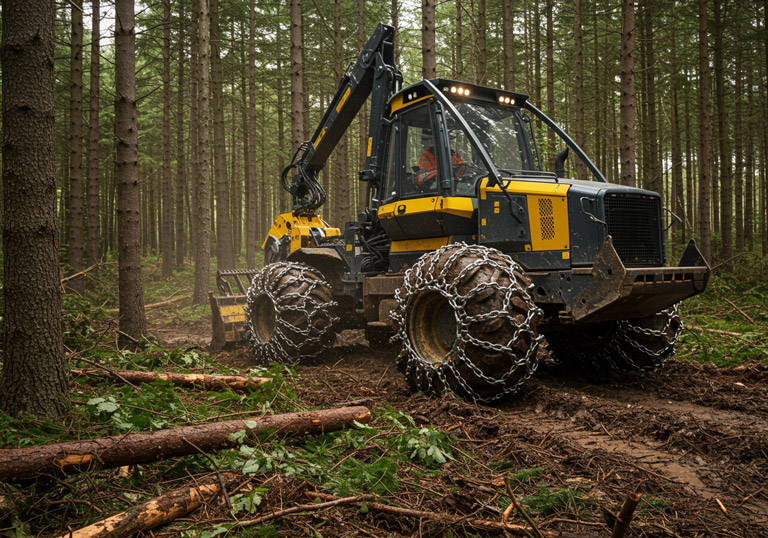Vehicles working in **forested areas** must navigate through rugged terrains, including mud, wet soil, fallen branches, and uneven ground. In such extreme conditions, **tire chains** are essential for ensuring optimal traction, preventing slippage, and protecting the tires from premature wear. Choosing the right chains enhances vehicle performance, improves safety, and reduces operating costs in forestry operations. However, incorrect selection or improper use of chains can lead to inefficiencies and increased maintenance costs.

The Importance of Using Tire Chains in Forested Areas
Adapting to Rough Terrain Conditions
Forested areas present unique challenges for vehicles, such as loose soil, thick mud, and unexpected obstacles like fallen logs or rocks. Without proper **tire chains**, vehicles can easily lose traction, making operations inefficient and even hazardous. Chains provide additional grip by increasing the friction between the tires and the terrain, ensuring smoother movement through uneven landscapes. This is especially crucial for forestry machinery, which needs to maintain stability while operating in remote locations.
Improving Safety and Operational Efficiency
Using **high-quality tire chains** significantly improves **safety in forestry operations** by preventing vehicles from slipping on wet or unstable ground. Additionally, chains enhance braking performance, allowing better control on steep inclines and slippery paths. Properly selected and installed tire chains also reduce the risk of tire damage, preventing costly downtime and extending the lifespan of expensive forestry tires. This results in lower maintenance expenses and more efficient operations.
Types of Tire Chains for Forestry Vehicles
The Strength of Steel Tire Chains
Steel tire chains are the most durable option for forestry applications. Designed to withstand rough terrains, these chains are highly resistant to abrasions caused by rocks, stumps, and sharp debris. Their reinforced construction ensures long-lasting performance, making them ideal for heavy forestry vehicles such as skidders and forwarders. However, their weight requires proper handling during installation and maintenance.
Advantages of Thick Steel Chains
For forestry machinery working in extreme conditions, **thick steel chains** provide superior protection and traction. Their heavy-duty design prevents excessive tire wear while improving grip on challenging surfaces. Additionally, these chains are corrosion-resistant, ensuring a longer service life in humid and muddy environments.
Studded Chains and Their Enhanced Grip
Studded tire chains offer increased traction on icy, muddy, or loose soil surfaces by embedding small metal spikes into the terrain. This additional grip is particularly useful in winter forestry operations where snow and ice create hazardous conditions. Studded chains also help distribute the vehicle’s weight more evenly, reducing the risk of getting stuck in deep mud.
Performance of Studded Chains in Forested Environments
Forestry vehicles using **studded chains** benefit from greater control on soft ground and steep inclines. The metal studs penetrate loose or compacted soil, ensuring stability even in the most demanding conditions. However, these chains may wear out faster when used on dry or solid terrain, so their usage should be carefully managed.
Composite and Hybrid Chains
Composite tire chains combine the benefits of different materials to create a lightweight yet durable solution. These chains are often easier to install and provide decent traction on moderate terrains. Hybrid chains, which incorporate both steel and synthetic components, offer a balance between durability and flexibility. They are suitable for forestry vehicles operating in mixed conditions.
Advantages of Lightweight and Durable Chains
Compared to traditional steel chains, **composite and hybrid chains** are lighter, making them easier to install and remove. They also produce less vibration and noise, providing a smoother ride. However, they may not be as durable as full-steel chains in extreme forestry environments.

Choosing the Right Tire Chains for Forestry Operations
Selecting Chains Based on Vehicle Type
Chains for Forestry Tractors
Forestry tractors require **reinforced tire chains** to ensure efficient maneuverability in deep mud, rocky paths, and steep inclines. These chains should provide excellent sidewall protection while maintaining flexibility for different types of terrain. Choosing chains with self-cleaning properties can prevent excessive mud buildup.
Recommended Chains for 4×4 Vehicles
4×4 off-road vehicles used in forestry work need tire chains that balance durability and ease of installation. These chains should be highly resistant to wear while offering excellent traction on slippery surfaces. Adjustable tensioning mechanisms can help ensure a secure fit and prevent chain displacement during rough operations.
Considering Terrain and Weather Conditions
Best Chains for Muddy and Soft Ground
For forestry vehicles working in muddy and soft terrain, tire chains with a wide contact surface are recommended. These chains prevent excessive sinking into the ground and improve traction. Mud-resistant designs also help prevent clogging, maintaining efficiency in wet environments.
Chains for Rocky and Uneven Terrain
In rocky forestry environments, reinforced steel chains provide superior protection against punctures and cuts. These chains should be designed to absorb impact while maintaining flexibility to adapt to uneven surfaces. High-tensile strength materials are essential for ensuring long-lasting performance in demanding terrains.
Best Practices for Installing and Maintaining Tire Chains
Proper Installation Techniques
Ensuring Secure Attachment
Proper installation of tire chains is essential to maximize their effectiveness and longevity. Chains should be evenly distributed around the tire to prevent imbalances that could affect vehicle control. Tightening mechanisms should be used to secure the chains in place while allowing some flexibility for movement.
Common Installation Mistakes
One of the most frequent Selecting Tire Chains for Vehicles Operating in Forested Areas
Vehicles working in **forested areas** must navigate through rugged terrains, including mud, wet soil, fallen branches, and uneven ground. In such extreme conditions, **tire chains** are essential for ensuring optimal traction, preventing slippage, and protecting the tires from premature wear. Choosing the right chains enhances vehicle performance, improves safety, and reduces operating costs in forestry operations. However, incorrect selection or improper use of chains can lead to inefficiencies and increased maintenance costs.

The Importance of Using Tire Chains in Forested Areas
Adapting to Rough Terrain Conditions
Forested areas present unique challenges for vehicles, such as loose soil, thick mud, and unexpected obstacles like fallen logs or rocks. Without proper **tire chains**, vehicles can easily lose traction, making operations inefficient and even hazardous. Chains provide additional grip by increasing the friction between the tires and the terrain, ensuring smoother movement through uneven landscapes. This is especially crucial for forestry machinery, which needs to maintain stability while operating in remote locations.
Improving Safety and Operational Efficiency
Using **high-quality tire chains** significantly improves **safety in forestry operations** by preventing vehicles from slipping on wet or unstable ground. Additionally, chains enhance braking performance, allowing better control on steep inclines and slippery paths. Properly selected and installed tire chains also reduce the risk of tire damage, preventing costly downtime and extending the lifespan of expensive forestry tires. This results in lower maintenance expenses and more efficient operations.
Types of Tire Chains for Forestry Vehicles
The Strength of Steel Tire Chains
Steel tire chains are the most durable option for forestry applications. Designed to withstand rough terrains, these chains are highly resistant to abrasions caused by rocks, stumps, and sharp debris. Their reinforced construction ensures long-lasting performance, making them ideal for heavy forestry vehicles such as skidders and forwarders. However, their weight requires proper handling during installation and maintenance.
Advantages of Thick Steel Chains
For forestry machinery working in extreme conditions, **thick steel chains** provide superior protection and traction. Their heavy-duty design prevents excessive tire wear while improving grip on challenging surfaces. Additionally, these chains are corrosion-resistant, ensuring a longer service life in humid and muddy environments.
Studded Chains and Their Enhanced Grip
Studded tire chains offer increased traction on icy, muddy, or loose soil surfaces by embedding small metal spikes into the terrain. This additional grip is particularly useful in winter forestry operations where snow and ice create hazardous conditions. Studded chains also help distribute the vehicle’s weight more evenly, reducing the risk of getting stuck in deep mud.
Performance of Studded Chains in Forested Environments
Forestry vehicles using **studded chains** benefit from greater control on soft ground and steep inclines. The metal studs penetrate loose or compacted soil, ensuring stability even in the most demanding conditions. However, these chains may wear out faster when used on dry or solid terrain, so their usage should be carefully managed.
Composite and Hybrid Chains
Composite tire chains combine the benefits of different materials to create a lightweight yet durable solution. These chains are often easier to install and provide decent traction on moderate terrains. Hybrid chains, which incorporate both steel and synthetic components, offer a balance between durability and flexibility. They are suitable for forestry vehicles operating in mixed conditions.
Advantages of Lightweight and Durable Chains
Compared to traditional steel chains, **composite and hybrid chains** are lighter, making them easier to install and remove. They also produce less vibration and noise, providing a smoother ride. However, they may not be as durable as full-steel chains in extreme forestry environments.
Choosing the Right Tire Chains for Forestry Operations
Selecting Chains Based on Vehicle Type
Chains for Forestry Tractors
Forestry tractors require **reinforced tire chains** to ensure efficient maneuverability in deep mud, rocky paths, and steep inclines. These chains should provide excellent sidewall protection while maintaining flexibility for different types of terrain. Choosing chains with self-cleaning properties can prevent excessive mud buildup.
Recommended Chains for 4×4 Vehicles
4×4 off-road vehicles used in forestry work need tire chains that balance durability and ease of installation. These chains should be highly resistant to wear while offering excellent traction on slippery surfaces. Adjustable tensioning mechanisms can help ensure a secure fit and prevent chain displacement during rough operations.
Considering Terrain and Weather Conditions
Best Chains for Muddy and Soft Ground
For forestry vehicles working in **muddy and soft terrain**, tire chains with a wide contact surface are recommended. These chains prevent excessive sinking into the ground and improve traction. Mud-resistant designs also help prevent clogging, maintaining efficiency in wet environments.
Chains for Rocky and Uneven Terrain
In **rocky forestry environments**, reinforced steel chains provide superior protection against punctures and cuts. These chains should be designed to absorb impact while maintaining flexibility to adapt to uneven surfaces. High-tensile strength materials are essential for ensuring long-lasting performance in demanding terrains.
Best Practices for Installing and Maintaining Tire Chains
Proper Installation Techniques
Ensuring Secure Attachment
**Proper installation of tire chains** is essential to maximize their effectiveness and longevity. Chains should be evenly distributed around the tire to prevent imbalances that could affect vehicle control. Tightening mechanisms should be used to secure the chains in place while allowing some flexibility for movement.
Common Installation Mistakes
One of the most frequent **installation mistakes** is leaving chains too loose or too tight, which can lead to premature wear or tire damage. Additionally, installing chains in the wrong orientation can reduce traction and compromise vehicle stability. Regularly checking chain positioning after installation ensures they remain secure during operation.
Routine Maintenance and Storage
Preventing Rust and Corrosion
To **extend the lifespan of tire chains**, regular cleaning is necessary to remove dirt, mud, and debris. Steel chains should be coated with rust-prevention treatments to protect against corrosion in wet forestry environments. Proper lubrication can also help maintain chain flexibility.
Storage Tips for Off-Season Periods
When not in use, tire chains should be stored in a dry and ventilated area to prevent rust and deterioration. Hanging the chains or keeping them in specialized storage containers can prevent tangling and damage. Performing a pre-season inspection ensures that all chains are in good condition before they are needed for future operations. is leaving chains too loose or too tight, which can lead to premature wear or tire damage. Additionally, installing chains in the wrong orientation can reduce traction and compromise vehicle stability. Regularly checking chain positioning after installation ensures they remain secure during operation.
Routine Maintenance and Storage
Preventing Rust and Corrosion
To extend the lifespan of tire chains, regular cleaning is necessary to remove dirt, mud, and debris. Steel chains should be coated with rust-prevention treatments to protect against corrosion in wet forestry environments. Proper lubrication can also help maintain chain flexibility.
Storage Tips for Off-Season Periods
When not in use, tire chains should be stored in a dry and ventilated area to prevent rust and deterioration. Hanging the chains or keeping them in specialized storage containers can prevent tangling and damage. Performing a pre-season inspection ensures that all chains are in good condition before they are needed for future operations.


